You’ve poured your heart, expertise, and countless hours into writing your manuscript. Now, the critical question arises: where to sell my ebook to maximize its reach and your revenue? The sheer number of platforms can feel overwhelming, each with its own set of rules, royalty structures, and audience demographics. Choosing the wrong one can mean the difference between a bestseller and a book lost in digital obscurity. This guide is designed to cut through the confusion and provide a clear, actionable roadmap for authors like you.
This comprehensive resource will move beyond surface-level descriptions. We will dive deep into the top 12 platforms for selling ebooks, from retail giants like Amazon KDP and Apple Books to direct-to-reader storefronts like Gumroad and Payhip. We will also explore powerful aggregators such as Draft2Digital and IngramSpark that can distribute your work globally with a single upload.
For each platform, you will find a detailed breakdown of its:
- Core features and unique selling points
- Royalty rates and payment schedules
- Distribution network and global reach
- Honest pros and cons based on real author experiences
Our goal is to equip you with the specific information needed to make a strategic decision that aligns with your publishing goals. Whether you're a first-time author, a seasoned professional seeking wider distribution, or a niche expert building a direct audience, this list has a solution tailored for you. We've included direct links and screenshots for every entry to simplify your research process. Let's find the perfect home for your ebook.
1. BarkerBooks
For authors seeking a comprehensive, white-glove solution that extends far beyond simple distribution, BarkerBooks stands out as a premier full-service publishing partner. Instead of just providing a platform where you can sell your ebook, BarkerBooks manages the entire journey from manuscript to global marketplace, making it an exceptional choice for writers who prioritize professional quality and expert guidance. With a proven track record of publishing over 7,500 authors and maintaining a stellar 4.9 Google rating, they offer a level of end-to-end support that is rare in the industry.
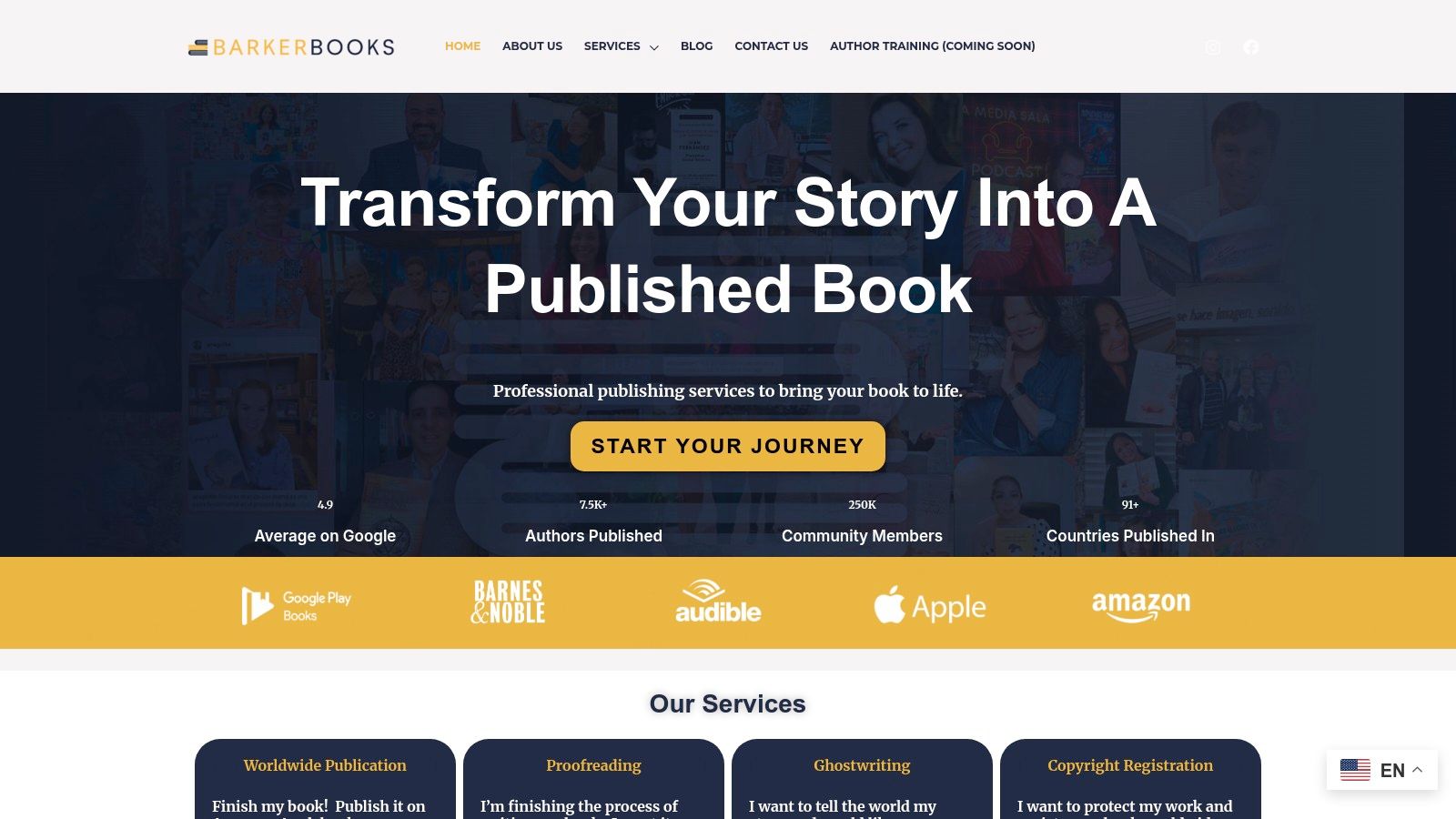
What truly distinguishes BarkerBooks is its holistic approach. The platform isn't merely a digital storefront; it’s a dedicated team of experts focused on transforming your work into a polished, marketable product. This integrated service model is ideal for authors who want to avoid the complexities of coordinating separate freelancers for editing, design, formatting, and marketing.
Core Features & Services
BarkerBooks offers a suite of services designed to cover every aspect of the publishing process:
- Professional Editorial Services: Their offerings include detailed proofreading, in-depth editorial editing, and even ghostwriting, ensuring your manuscript is flawless.
- High-Quality Design: They provide bespoke cover design, professional interior layout, and innovative 3D promotional videos to make your book visually compelling.
- Global Distribution Network: Your ebook is distributed to major retailers like Amazon Kindle, Apple Books, Barnes & Noble, and Google Books, reaching readers in over 91 countries.
- Comprehensive Marketing: BarkerBooks handles crucial promotional activities, including targeted social media advertising campaigns to connect you with your ideal audience.
- Administrative Management: They manage essential administrative tasks such as ISBN registration and copyright protection, freeing you to focus on writing.
Pricing and Packages
BarkerBooks operates on a package-based model, offering three distinct tiers to cater to different author needs and budgets.
| Package | Key Features | Best For |
|---|---|---|
| Essential | Core editing, design, distribution, and ISBN registration. | Authors on a budget needing a professional launch. |
| Professional | All Essential features plus advanced marketing and coaching. | Authors seeking to maximize their book's reach. |
| Elite | All Professional features plus multilingual publication, audiobook production, and tailored marketing. | Authors aiming for a global, multi-format literary impact. |
Practical Considerations
While BarkerBooks provides a powerful, all-in-one solution, it's important to note that it operates differently from a DIY platform like Amazon KDP. It’s an investment in a service, not just a tool. While some advanced features are reserved for higher-tier packages, the value lies in the seamless, expert-led experience and the high-quality final product. Authors consistently praise their professionalism and heartfelt client support, making it a trusted partner for achieving lasting literary success. For a deeper dive into the specifics of their process, you can explore their detailed guide on how to publish an ebook with BarkerBooks.
Website: barkerbooks.com
2. Amazon Kindle Direct Publishing (KDP)
When authors ask, "where to sell my ebook," Amazon’s Kindle Direct Publishing (KDP) is often the first platform that comes to mind, and for good reason. As the undisputed giant of the ebook market, KDP provides direct access to millions of readers actively browsing the Kindle Store. Its sheer scale is its primary advantage, offering a built-in audience that is nearly impossible to replicate elsewhere. The platform's user-friendly interface simplifies the entire publishing process, from uploading your manuscript to tracking real-time sales data.
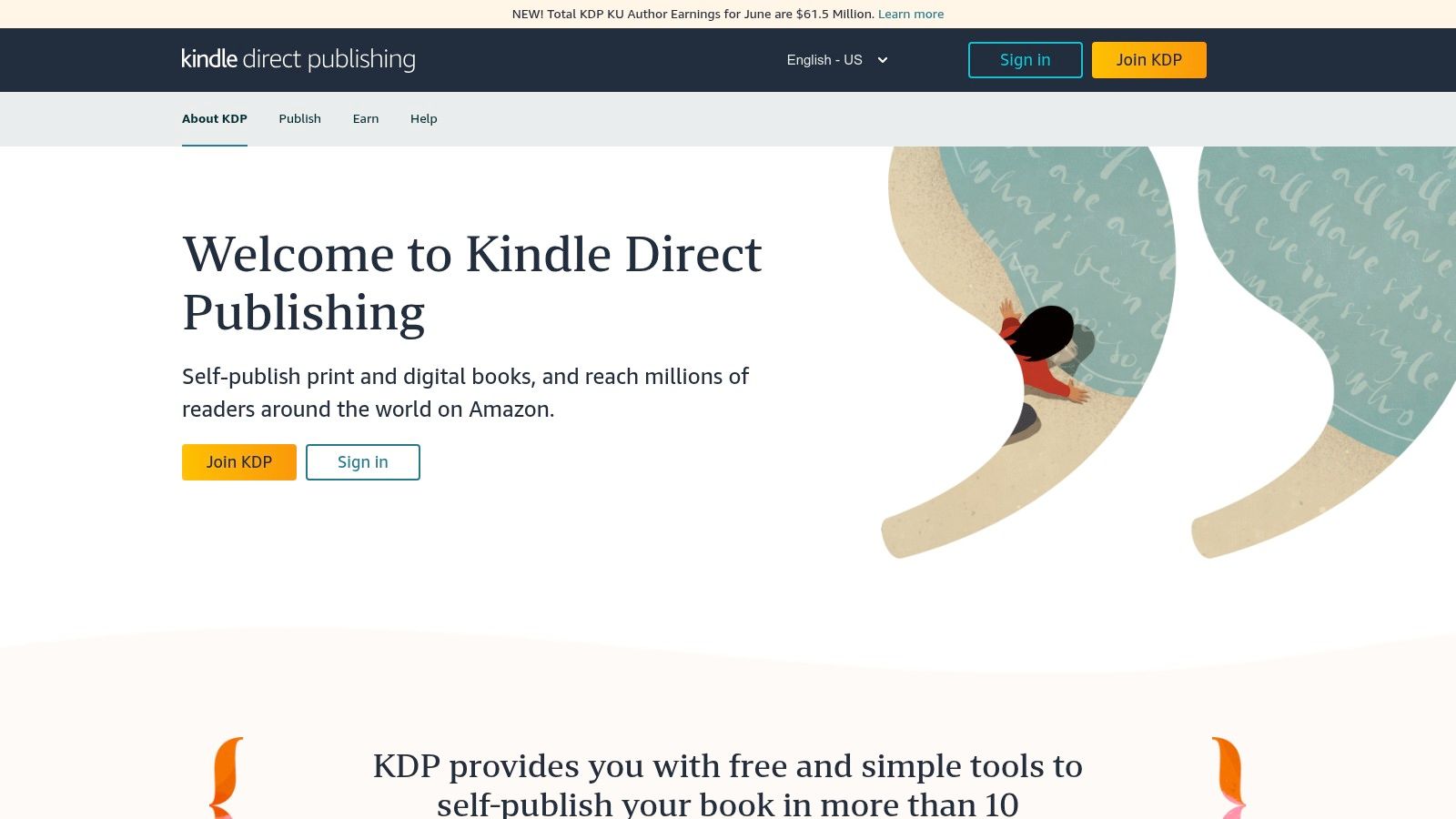
What makes KDP unique is its integrated ecosystem. Authors can publish both ebooks and print-on-demand paperbacks from a single dashboard, creating a seamless experience for readers who prefer different formats. It also provides powerful, albeit exclusive, marketing tools.
Key Feature: The KDP Select program allows authors to enroll their ebook in Kindle Unlimited (a subscription service) and the Kindle Owners' Lending Library. This can dramatically increase readership and visibility, especially for new authors, though it requires a 90-day exclusivity commitment to Amazon.
KDP Royalty & Exclusivity Considerations
Authors can choose between two royalty plans: 35% or 70%. To qualify for the higher 70% rate, your ebook must be priced between $2.99 and $9.99. However, this option comes with a small "delivery fee" based on your ebook's file size, which is deducted from your earnings.
Pros:
- Unmatched Reach: Direct access to the largest ebook marketplace in the world.
- Integrated Marketing: Built-in promotional tools like Kindle Countdown Deals and Free Book Promotions.
- Print-on-Demand: Easily create and sell paperback versions alongside your ebook.
Cons:
- Exclusivity Clause: Enrolling in KDP Select prevents you from selling your ebook on any other platform.
- Delivery Fees: The 70% royalty option includes per-megabyte delivery costs that can impact earnings for image-heavy books.
For authors prioritizing maximum exposure and a streamlined process, KDP is an essential starting point.
Website: https://kdp.amazon.com/
3. Apple Books
For authors wondering where to sell my ebook beyond Amazon, Apple Books presents a premium, high-value alternative. It provides direct access to a global audience of dedicated iOS users who browse and buy directly on their iPhones, iPads, and Macs. The platform is known for its clean, user-friendly interface and its strong support for visually rich, interactive content, making it an excellent choice for children's books, cookbooks, or enhanced textbooks.
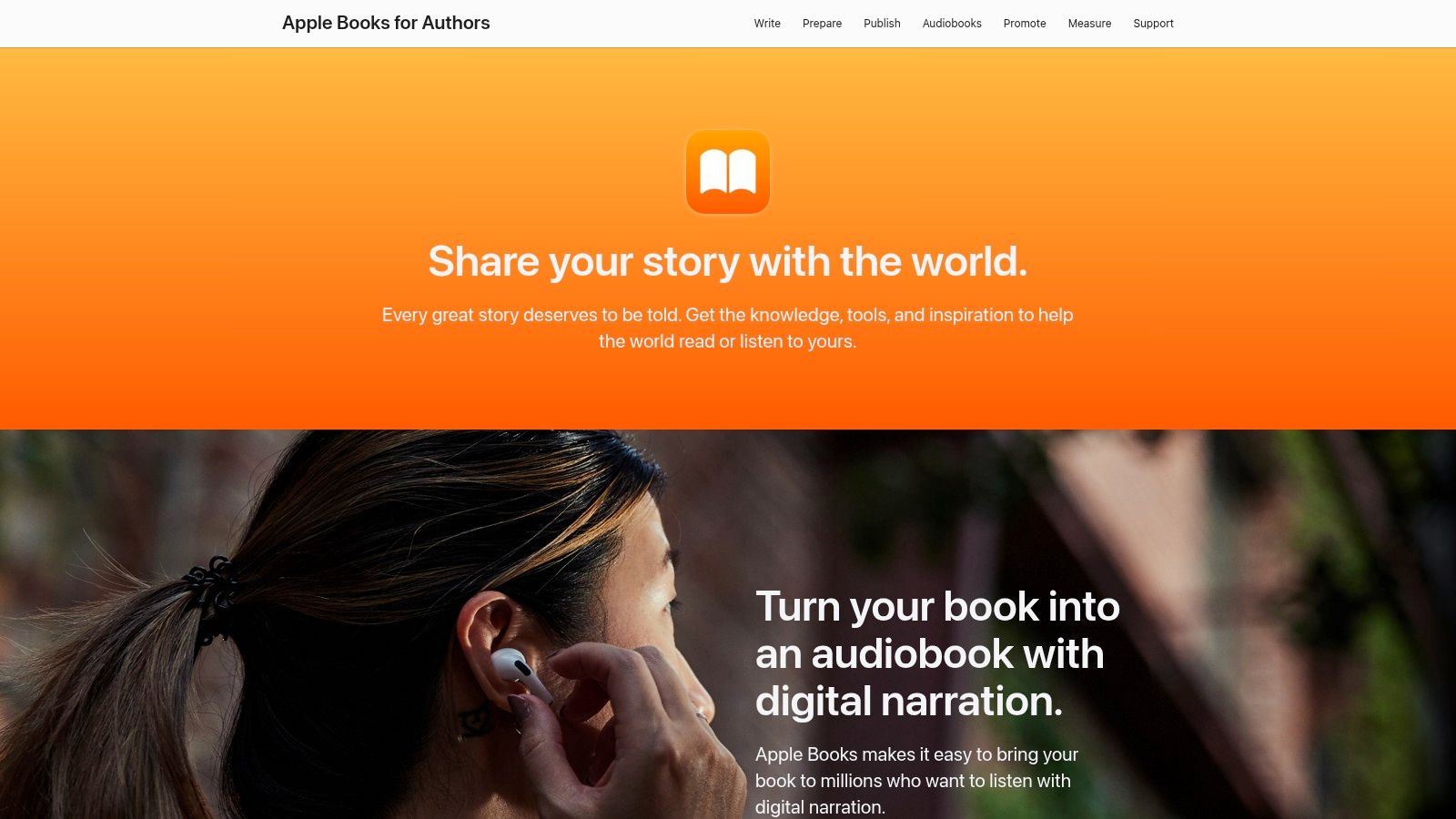
What makes Apple Books stand out is its author-friendly royalty structure and lack of exclusivity. You can sell on Apple Books and other platforms simultaneously, maximizing your potential reach without being locked into a single ecosystem. This flexibility is a significant draw for authors building a wide distribution strategy.
Key Feature: A straightforward, flat 70% royalty rate on all sales, regardless of price. This simple, transparent model has no hidden delivery fees, allowing authors to predict their earnings more accurately.
Apple Books Royalty & Exclusivity Considerations
Apple offers a consistent 70% royalty across the board, which applies to sales in over 50 countries. There are no pricing-range restrictions to qualify for this rate, and importantly, no delivery fees are deducted from your earnings, which is a major advantage for authors with large, image-heavy files.
Pros:
- High Royalty Rate: A clean, flat 70% royalty with no complex rules or delivery fees.
- No Exclusivity: You are free to sell your ebook on any other retail platform.
- Multimedia Support: Excellent for creating enhanced ebooks with audio, video, and interactive elements.
Cons:
- Mac Requirement: Direct publishing requires a Mac. PC users must use an aggregator service to get their books onto the platform.
- Complex Formatting: The .epub formatting guidelines can be stricter and more complex than those of other retailers.
For authors targeting a tech-savvy, affluent readership and who value non-exclusive terms, Apple Books is a top-tier sales channel.
Website: https://authors.apple.com/
4. Kobo Writing Life
For authors seeking to expand their global footprint beyond Amazon, Kobo Writing Life (KWL) is an essential platform to consider when asking "where to sell my ebook." As a major international player, particularly strong in Canada and across Europe and Asia, Kobo offers a direct path to readers in markets that other platforms may not reach as effectively. The platform prides itself on a straightforward, author-friendly experience, making it easy to upload, price, and manage your titles for a worldwide audience.
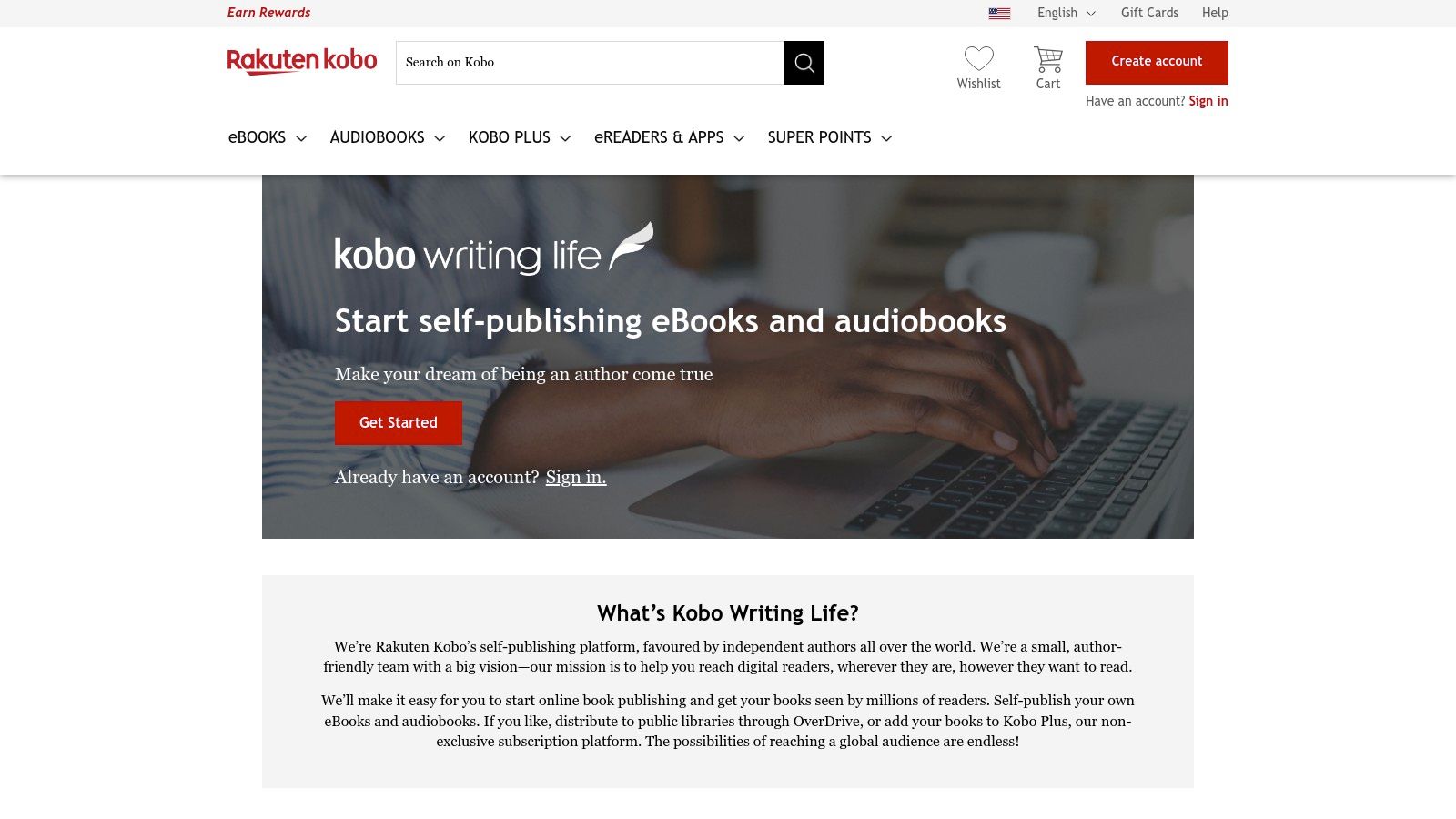
What sets Kobo apart is its extensive network of partnerships with international retailers and libraries, which significantly boosts distribution. Unlike the exclusivity often demanded by other giants, Kobo empowers authors to pursue a "wide" distribution strategy, allowing them to publish freely across multiple sites.
Key Feature: Deep integration with OverDrive, the largest digital content distributor for libraries and schools worldwide. This provides a valuable, often untapped, revenue and discovery stream for indie authors, getting their work into library catalogs globally.
KWL Royalty & Exclusivity Considerations
Kobo’s royalty structure is competitive and transparent. Authors earn 70% royalties on ebooks priced at or above $2.99 (or its equivalent in other currencies). For books priced below this threshold, the royalty rate is 45%. Importantly, Kobo does not charge delivery fees, meaning your 70% royalty is a true 70% of the list price.
Pros:
- Strong International Reach: Excellent distribution in over 190 countries, with a notable presence in non-U.S. markets.
- No Exclusivity: You are free to sell your ebook on any other platform without restriction.
- Library Distribution: Partnership with OverDrive gets your book in front of library patrons.
Cons:
- Smaller U.S. Market Share: Kobo is not the dominant player in the United States ebook market.
- Lower Royalties on Cheap Books: The 45% rate for books under $2.99 is less favorable than some competitors.
For authors pursuing a wide strategy and aiming for a truly global readership, Kobo Writing Life is a non-negotiable part of their distribution plan.
Website: https://www.kobo.com/writinglife
5. Barnes & Noble Press
For authors asking "where to sell my ebook" with a desire to reach a more traditional book-buying audience, Barnes & Noble Press presents a compelling option. As the self-publishing arm of the largest brick-and-mortar bookseller in the United States, it provides direct access to the NOOK device ecosystem and a loyal customer base that trusts the B&N brand. The platform is straightforward, allowing authors to easily upload their manuscript and cover to reach millions of dedicated readers.
What makes Barnes & Noble Press a unique consideration is its bridge between the digital and physical retail worlds. While its digital market share is smaller than Amazon's, its connection to physical bookstores offers promotional opportunities unavailable on purely digital platforms. This makes it an excellent supplementary channel for authors who want to diversify their sales streams beyond a single retailer.
Key Feature: Authors receive a flat 70% royalty on all ebook sales priced at $0.99 or higher, with no delivery fees. This simple and transparent royalty structure is highly attractive, especially for authors of image-heavy books who might be penalized on other platforms.
B&N Press Royalty & Exclusivity Considerations
The platform’s royalty model is refreshingly simple. Authors earn a consistent 70% on ebooks, regardless of price (as long as it's over $0.99), and there are no exclusivity requirements. This freedom allows you to publish on B&N Press while also listing your ebook on Amazon, Kobo, and other stores simultaneously, creating a "wide" distribution strategy.
Pros:
- Established Brand: Leverage the trust and recognition of the Barnes & Noble name.
- Simple Royalties: A straightforward and competitive 70% royalty rate with no hidden fees.
- No Exclusivity: You retain the freedom to sell your ebook on any other platform.
Cons:
- Smaller Market Share: The NOOK user base is significantly smaller than the Kindle market.
- Limited Global Reach: Its primary audience is concentrated within the United States.
For authors seeking to diversify their income and tap into a dedicated, traditional reader base, Barnes & Noble Press is a vital component of a wide publishing strategy.
Website: https://press.barnesandnoble.com/
6. Google Play Books
Leveraging the power of the world's largest search engine, Google Play Books offers authors a direct channel to a massive global audience, particularly those on Android devices. For authors wondering where to sell my ebook beyond the usual suspects, Google’s platform provides a significant opportunity. It stands out by integrating book discovery directly into the Google ecosystem, making your title visible to billions of potential readers searching for related topics.
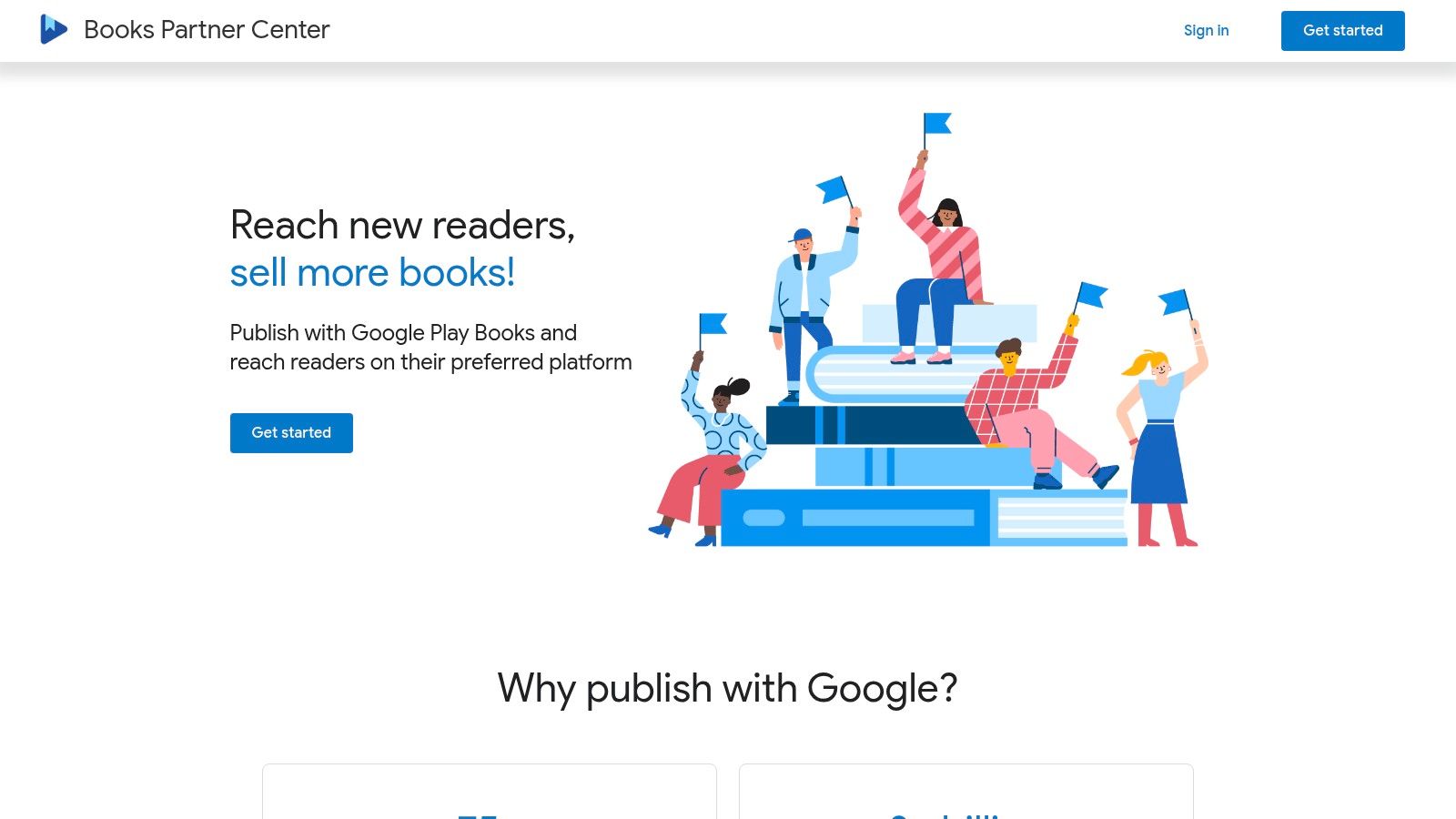
Unlike closed ecosystems, Google Play Books excels at making your content discoverable across its network. Its strength lies in reaching readers in over 75 countries, many of whom are deeply embedded in the Android and Google environment.
Key Feature: The platform's powerful analytics provide deep insights into reader engagement and sales trends. Authors can see not just where their book is selling, but also gather data on how readers are interacting with the content, which can be invaluable for future marketing efforts.
Google Play Books Royalty & Platform Considerations
Google offers a straightforward 70% royalty rate on most sales, provided the book is priced within specific thresholds that vary by country. This competitive rate applies across its vast international market without the complex delivery fees seen on some other platforms. This makes it an attractive part of a broader sales strategy, often utilized through various book distribution services.
Pros:
- Vast Reach: Direct access to billions of Android users and the wider Google ecosystem.
- Generous Royalty: A competitive 70% royalty rate in most major markets.
- Powerful Analytics: Detailed reports on sales, reader demographics, and engagement.
Cons:
- Complex Setup: The initial account setup and verification process can be more involved than on other platforms.
- Less Intuitive Interface: Some authors find the publisher dashboard less user-friendly compared to competitors like KDP.
For authors seeking to diversify their sales channels and tap into the immense Android market, Google Play Books is a crucial platform to consider.
Website: https://play.google.com/books/publish/
7. Smashwords
For authors looking for the broadest possible reach without juggling multiple platforms, Smashwords is a powerhouse aggregator. Instead of being a single storefront, it acts as a massive distribution hub, pushing your ebook out to a vast network of global retailers and library services. This makes it an excellent choice for authors wondering where to sell their ebook beyond the major players, reaching readers on platforms like Apple Books, Barnes & Noble, Kobo, and OverDrive all from one dashboard. The platform champions an open, non-exclusive approach to publishing.
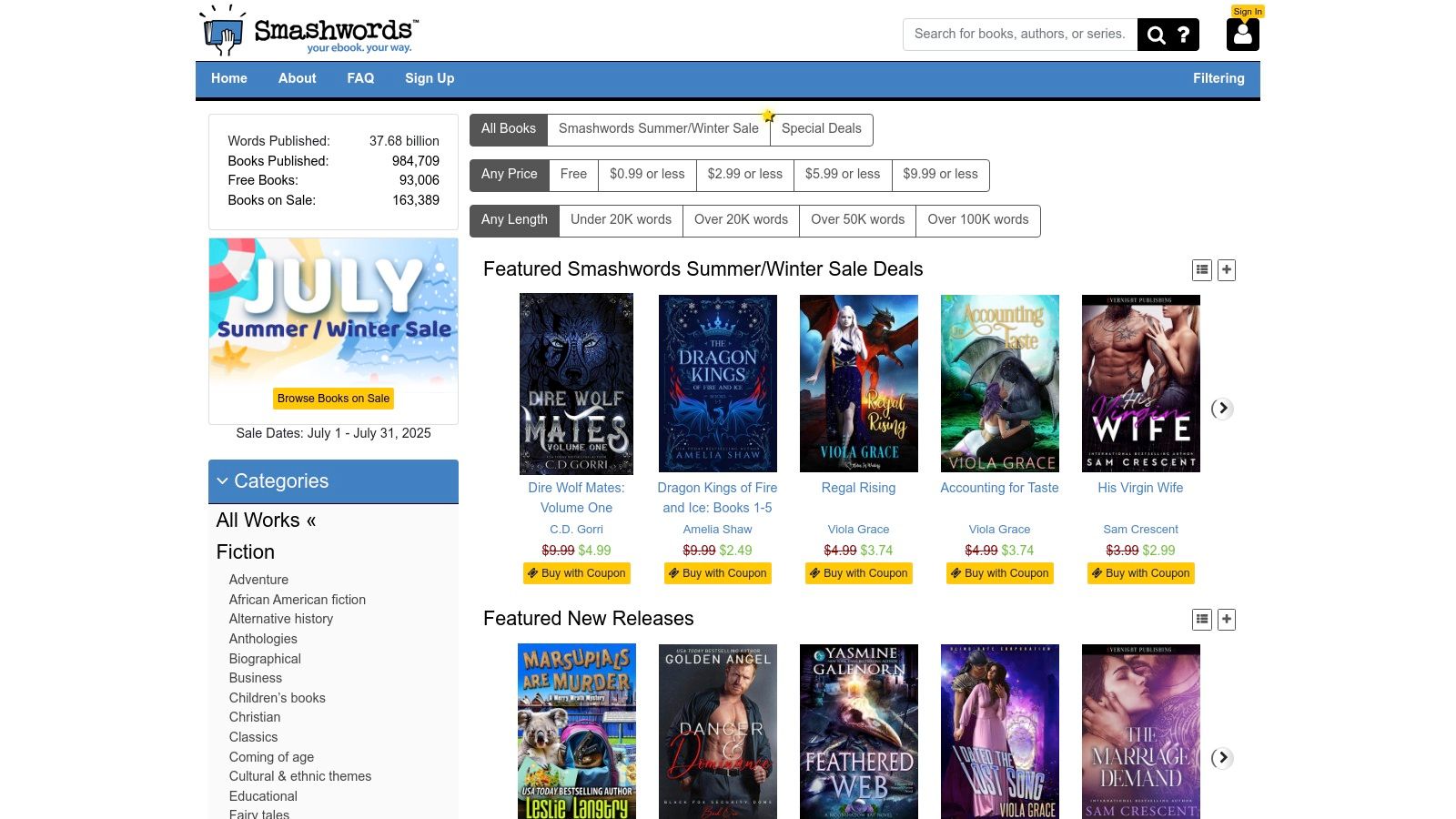
What makes Smashwords unique is its combination of wide distribution and high direct-sale royalties. While it sends your book everywhere, it also maintains its own retail store where you can earn significantly more per sale. This dual approach provides both maximum visibility and a high-earning sales channel.
Key Feature: The free "Smashwords Style Guide" and its automated "Meatgrinder" conversion tool help authors format their manuscripts to meet the strict requirements of its many retail partners, ensuring a clean, professional-looking ebook across all devices.
Smashwords Royalty & Exclusivity Considerations
Smashwords offers a very attractive 85% royalty rate for sales made directly through the Smashwords Store. For sales through its partner retailers, you'll earn 60% of the list price after the retailer takes its cut. The platform is completely non-exclusive, allowing you to publish your work anywhere else you choose, including KDP, as long as you are not enrolled in KDP Select.
Pros:
- Broad Distribution: Reach dozens of retailers and thousands of public libraries from a single upload.
- No Exclusivity: You retain the freedom to sell your ebook on any other platform simultaneously.
- High Royalty Rates: Earn up to 85% on direct sales through the Smashwords Store.
Cons:
- Strict Formatting: The "Meatgrinder" auto-formatter has very rigid requirements that can be challenging for beginners.
- Less Retailer Control: You have less direct control over pricing and promotions on individual partner sites.
Smashwords is ideal for authors who prioritize wide distribution and want to "set it and forget it," reaching a diverse global audience with minimal administrative work.
Website: https://www.smashwords.com/
8. Draft2Digital
For authors who want the benefits of wide distribution without the hassle of managing multiple platforms, Draft2Digital is a leading choice. It acts as an aggregator, taking your single manuscript and distributing it across a vast network of online retailers and library systems, including Barnes & Noble, Kobo, and Apple Books. This makes it an ideal solution when deciding where to sell your ebook beyond the Amazon ecosystem. The platform is celebrated for its exceptional customer support and a remarkably simple, author-focused interface.

What truly sets Draft2Digital apart are its free, value-added services. The platform offers professional-grade formatting and conversion, turning a simple Word document into a polished ebook file. It also provides tools for creating universal book links and automated back matter, which can automatically insert links to your other books across your entire catalog.
Key Feature: The platform's 'single-dashboard' approach simplifies wide distribution. You upload once and can manage pricing, updates, and sales reports for all connected retailers from one central location, saving immense time and effort.
Draft2Digital Royalty & Exclusivity Considerations
Draft2Digital operates on a commission model, taking approximately 10% of the ebook's retail price as their fee. This means you earn about 60% of the list price, as the retailer takes its cut first. There are no upfront costs for formatting or distribution, and critically, there are no exclusivity requirements.
Pros:
- Comprehensive Distribution: Reach major retailers and library systems from a single upload.
- Author-Friendly Tools: Free formatting, conversion, and automated back matter updates are included.
- No Exclusivity: You retain the freedom to sell your ebook anywhere else, including directly from your own website or on Amazon KDP (without KDP Select).
Cons:
- Commission-Based: The platform takes a percentage of every sale as its fee.
- Less Promotional Control: You have limited access to retailer-specific marketing tools, like Kobo's promotions or Apple's featuring opportunities.
Draft2Digital is perfect for authors prioritizing simplicity and broad market reach without being locked into a single ecosystem.
Website: https://www.draft2digital.com/
9. Payhip
For authors who prioritize direct control and building a personal brand, Payhip offers a compelling answer to the question, "where to sell my ebook?" Instead of acting as a massive marketplace, Payhip provides the tools to create a sleek, customizable digital storefront that you can embed directly on your own website or use as a standalone sales page. This direct-to-consumer model is its core strength, allowing you to own the customer relationship and data from start to finish. The platform is incredibly user-friendly, simplifying the process of uploading products, setting prices, and managing sales.
What sets Payhip apart is its robust suite of built-in marketing features designed for independent creators. You can run affiliate programs, create discount codes, and offer social discounts to incentivize sharing. This empowers you to manage your own promotional campaigns without relying on a third-party retailer's algorithms.
Key Feature: Payhip automatically handles the complexities of EU & UK VAT, calculating and remitting the correct tax for each sale. This removes a significant administrative burden for authors selling to a global audience, making international sales seamless.
Payhip Royalty & Marketing Considerations
Payhip offers a simple pricing structure with a free plan that includes all features but carries a 5% transaction fee. Paid plans are available to reduce or eliminate this fee. Since you are selling directly, you have complete control over pricing and promotions, with no exclusivity clauses tying you down.
Pros:
- Complete Control: You set the price, own the customer list, and manage your own storefront.
- Built-in Marketing Tools: Integrated affiliate marketing, coupons, and social discounts to boost sales.
- Automated VAT Handling: Simplifies selling to customers in the European Union and the United Kingdom.
Cons:
- Requires Author Marketing: You are entirely responsible for driving traffic to your store; there is no built-in audience.
- Transaction Fees: The free plan includes a 5% fee on top of standard Stripe/PayPal processing fees.
Payhip is ideal for entrepreneurial authors with an established online presence who want to maximize their profits and build a direct connection with their readers. To make the most of the platform, you'll need effective book promotion ideas to drive traffic to your store.
Website: https://payhip.com/
10. Gumroad
For authors who want complete control over their sales process and direct communication with their audience, Gumroad is an exceptional choice. Unlike traditional ebook retailers, Gumroad is a direct-to-consumer platform that empowers creators to sell digital products, including ebooks, from a simple, customizable storefront. This model is perfect for authors who have already built an audience through a blog, social media, or email list and are wondering where to sell my ebook without a middleman.
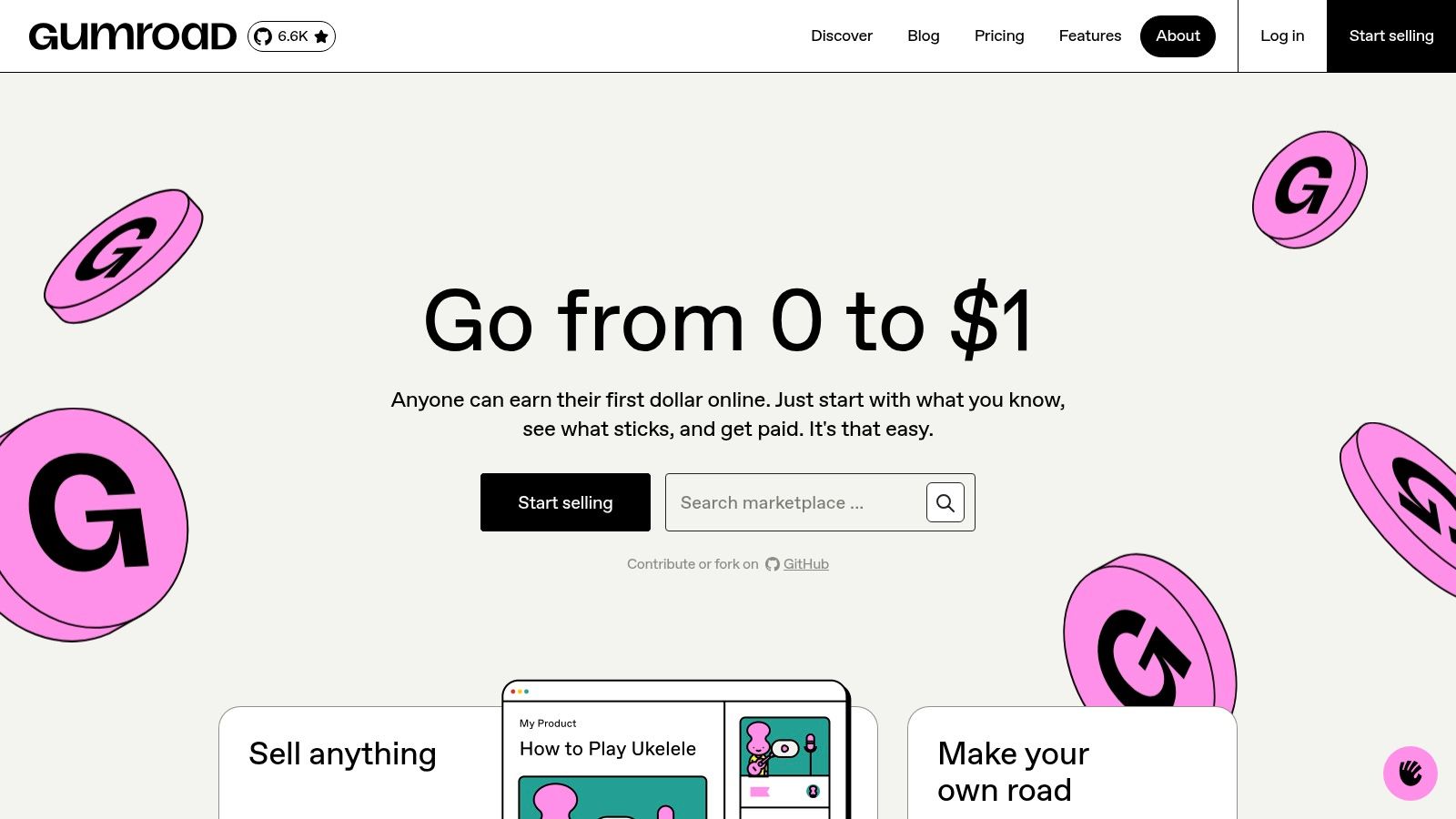
Gumroad’s strength lies in its simplicity and flexibility. You can be up and running in minutes, creating a product page that supports various media to showcase your work effectively. The platform handles file delivery and payment processing, freeing you to focus on creation and marketing.
Key Feature: The "Pay What You Want" pricing model is a standout feature. It allows authors to set a minimum price (even $0) and let readers pay what they feel the book is worth, which can be a powerful tool for building goodwill and maximizing revenue from a loyal fanbase.
Gumroad Royalty & Exclusivity Considerations
Gumroad does not charge a monthly fee, making it accessible to everyone. Instead, it takes a flat 10% fee from each sale, which simplifies earnings calculations. This fee includes credit card processing, and there are no hidden costs. There are absolutely no exclusivity requirements, so you are free to sell your ebook on Gumroad alongside any other platform, including Amazon KDP (as long as you aren't enrolled in KDP Select).
Pros:
- Direct Customer Access: You get the email addresses of your buyers, allowing you to build a direct marketing list.
- Pricing Flexibility: Offers fixed price, "pay what you want," pre-orders, and even subscriptions.
- Simple Interface: Extremely easy to set up a product page and start selling quickly.
Cons:
- No Built-in Audience: You are entirely responsible for driving traffic to your sales page.
- Higher Transaction Fees: The 10% flat fee can be higher than the variable fees on some other platforms, especially for higher-priced items.
Gumroad is ideal for the entrepreneurial author who values independence and a direct relationship with readers.
Website: https://gumroad.com/
11. Sellfy
For authors who prioritize building their own brand and selling directly to their audience, Sellfy offers a sleek and straightforward e-commerce solution. Unlike aggregator platforms, Sellfy helps you create a dedicated, customizable online storefront where you are in complete control. This approach is ideal for authors who have already established a following on social media or a blog and want to offer a seamless purchasing experience without sending readers to a third-party marketplace.
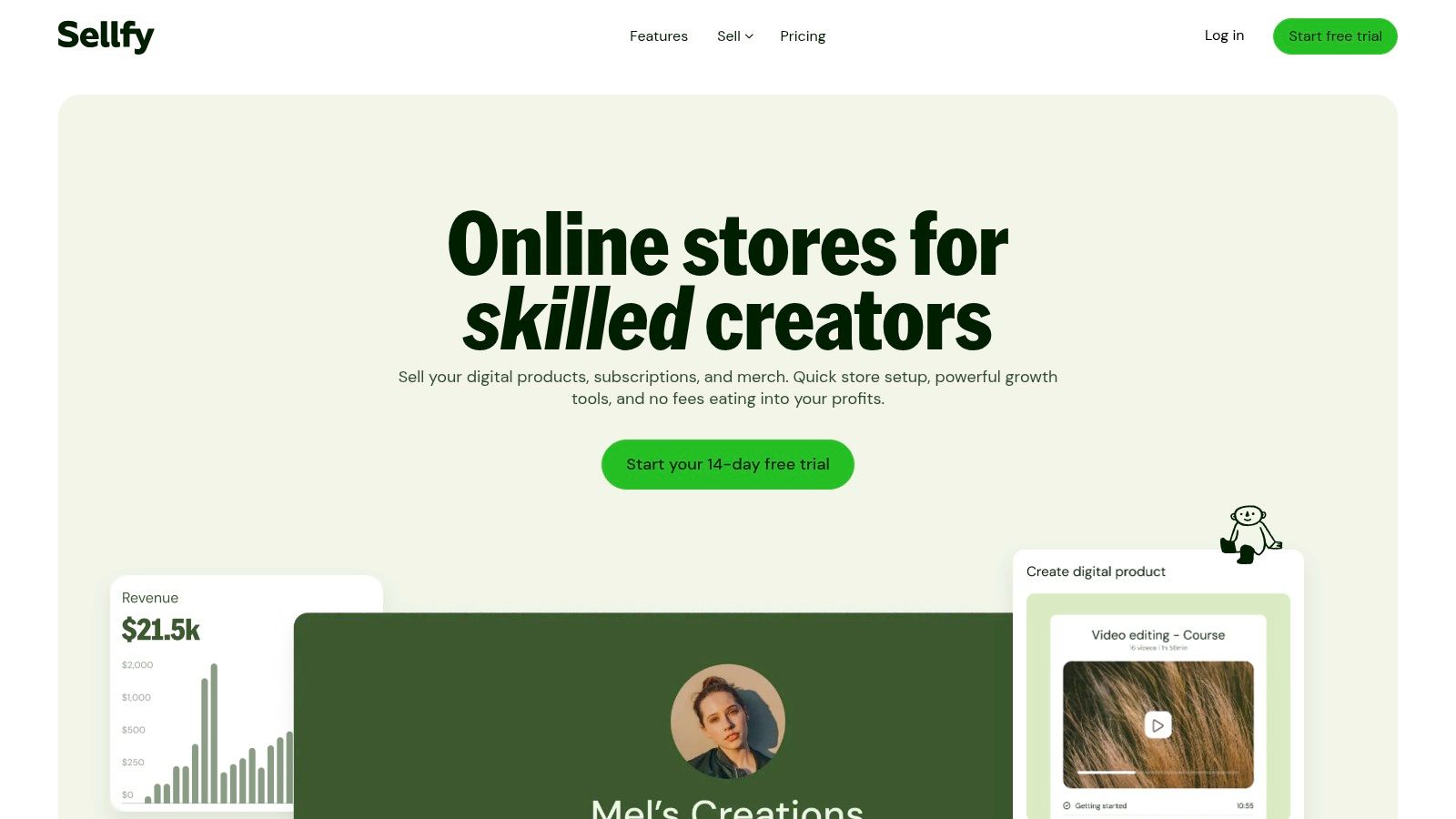
Sellfy simplifies the process of selling digital products, handling secure file delivery and payment processing automatically. This means when a reader buys your ebook, they get an instant download link, and you get paid without any manual intervention.
Key Feature: Sellfy’s "Buy Now" buttons and embeddable product cards allow you to integrate your sales process directly into your existing website, blog, or even social media posts. This turns any piece of content into a potential point of sale, making it an excellent tool for content-driven author marketing.
Sellfy Royalty & Exclusivity Considerations
Sellfy operates on a monthly subscription model, but the significant advantage is that it charges zero transaction fees on its paid plans. This means you keep 100% of your revenue beyond the payment processor's standard fee (e.g., PayPal or Stripe). There are no exclusivity requirements, so you are free to sell your ebook on Sellfy alongside any other platform you choose.
Pros:
- Direct-to-Consumer: Build your own brand and customer email list.
- No Transaction Fees: Keep more of your revenue on paid subscription tiers.
- Integrated Marketing: Built-in tools for email marketing, discount codes, and upselling.
Cons:
- Subscription Cost: Requires a monthly fee to access the best features, which may be a barrier for new authors.
- You Drive the Traffic: Success depends entirely on your own marketing efforts to bring readers to your store.
Sellfy is the answer for entrepreneurial authors asking "where to sell my ebook" who want full control and direct customer relationships.
Website: https://sellfy.com/
12. IngramSpark
IngramSpark is a powerhouse for authors who want to think beyond a single retailer and are serious about global distribution. While many platforms focus solely on digital sales, IngramSpark excels at providing a comprehensive solution for both ebooks and print-on-demand books, making it a crucial tool for those wondering where to sell my ebook on a worldwide scale. Its primary strength lies in its vast distribution network, connecting your work to thousands of online retailers, physical bookstores, and libraries.
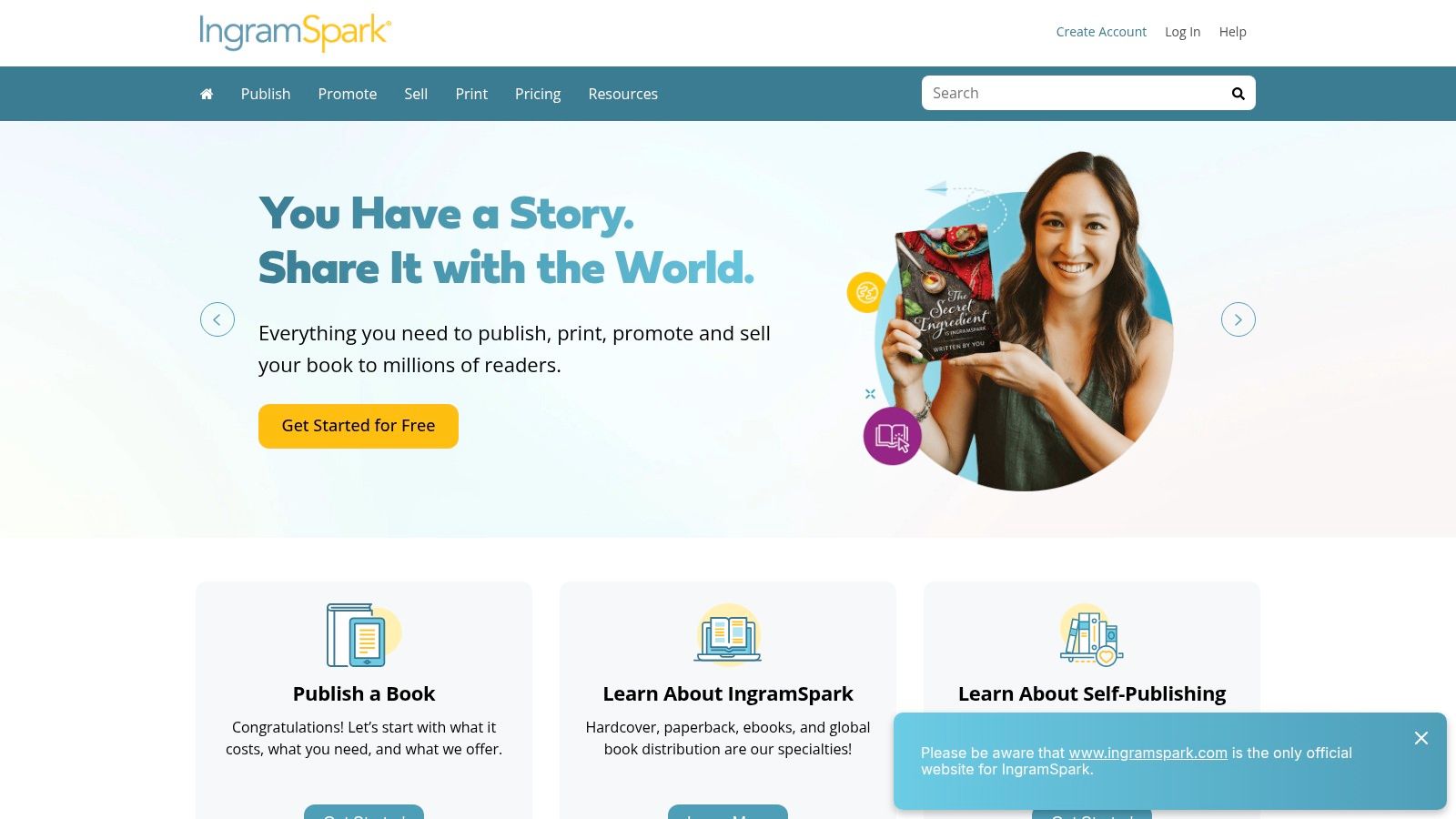
Unlike direct-to-retailer platforms, IngramSpark acts as an aggregator, pushing your book into channels that are otherwise difficult to access. This makes it an ideal choice for authors aiming to establish a professional presence and get their books into the hands of booksellers and librarians. The platform is geared towards those who see themselves as author-publishers rather than just writers.
Key Feature: The platform’s unrivaled global distribution network provides access to over 40,000 retailers and libraries. This allows your print book to be ordered by brick-and-mortar stores, a significant advantage over many ebook-only or single-retailer services.
IngramSpark Royalty & Fee Considerations
IngramSpark's model involves initial setup fees for each format (ebook and print), although these are sometimes waived during promotional periods. Royalties are calculated based on the wholesale price you set, minus printing costs (for print books). For ebooks, you receive 40% of the list price on sales through their retail partners.
Pros:
- Extensive Distribution Network: The best in the business for reaching a global market of retailers and libraries.
- Print-on-Demand: High-quality print options, including hardcover, make your book available to physical bookstores.
- Professional Credibility: Being in the Ingram catalog is a mark of professional publishing.
Cons:
- Setup and Revision Fees: There are costs to upload your book and make revisions after it's published.
- Complex Interface: The dashboard and setup process can be less intuitive and have a steeper learning curve than simpler platforms.
For authors with a long-term strategy focused on broad availability and professional-grade print options, IngramSpark is an indispensable partner.
Website: https://www.ingramspark.com/
Top 12 Ebook Selling Platforms Comparison
| Platform | Core Features & Services | User Experience & Quality ★ | Value & Pricing 💰 | Target Audience 👥 | Unique Selling Points ✨ |
|---|---|---|---|---|---|
| 🏆 BarkerBooks | Full-service publishing: editing, design, distribution | ★★★★★ (4.9 Google rating) | Packages: Essential to Elite 💰 | New & experienced authors 👥 | 3D promo videos, multilingual, global reach ✨ |
| Amazon Kindle Direct Publishing (KDP) | eBooks & paperbacks, Kindle Unlimited, promo tools | ★★★★☆ (large user base) | Up to 70% royalties 💰 | Self-publishing authors 👥 | Kindle-specific promos, broad reach ✨ |
| Apple Books | 70% royalties, no exclusivity, enhanced multimedia | ★★★★☆ | Flat 70% royalty 💰 | iOS device users & authors 👥 | Multimedia eBooks, affluent audience ✨ |
| Kobo Writing Life | 70% royalties, 190+ countries, local retail partnerships | ★★★★ | Up to 70% royalties 💰 | International authors 👥 | Strong in non-English markets ✨ |
| Barnes & Noble Press | 70% royalties, NOOK & physical stores | ★★★★ | 70% royalty 💰 | U.S.-focused authors 👥 | In-store events, physical distribution ✨ |
| Google Play Books | Up to 70% royalties, global in 75+ countries | ★★★★ | Up to 70% royalties 💰 | Android & Google users 👥 | Google ecosystem integration ✨ |
| Smashwords | Up to 85% royalties direct, wide distributor network | ★★★★ | Up to 85% royalties 💰 | Authors wanting broad reach 👥 | Free formatting, wide retailer access ✨ |
| Draft2Digital | Up to 90% net sales, multi-retailer distribution | ★★★★ | Up to 90% net sales 💰 | Beginners & pros 👥 | Free formatting, automatic updates ✨ |
| Payhip | Direct sales, customizable storefront | ★★★★ | Transaction fees on lower plans 💰 | Indie authors with marketing focus 👥 | Full sales control, marketing tools ✨ |
| Gumroad | Digital sales, subscriptions, pay-what-you-want pricing | ★★★★ | No monthly fees, higher tx fees 💰 | Creators selling varied products 👥 | Flexible pricing, email marketing ✨ |
| Sellfy | Storefront + payment processing, marketing tools | ★★★★ | Monthly subscription 💰 | Creators wanting ease & features 👥 | No transaction fees on paid plans ✨ |
| IngramSpark | Global print & eBook distribution, print-on-demand | ★★★★ | Setup fees per format 💰 | Publishers & authors 👥 | Print & digital, vast retail network ✨ |
Crafting Your Ebook Sales Strategy: Your Path Forward
Navigating the landscape of ebook distribution can feel like a monumental task, but after reviewing the twelve leading platforms, from retail giants like Amazon KDP to direct-to-reader tools like Gumroad, a clear path emerges. The central takeaway is this: the best place to sell your ebook is not a single platform, but a strategic combination of platforms that align with your specific goals, genre, and desired level of control. The question isn't just "where to sell my ebook," but rather, "how and where can I build a sustainable author career?"
The journey you've taken through this guide reveals a fundamental choice every author must make: exclusivity versus wide distribution. Going exclusive with Amazon KDP through KDP Select offers unparalleled access to its massive reader base and powerful promotional tools like Kindle Unlimited. However, this path means forfeiting sales on all other platforms. Conversely, going wide by using an aggregator like Draft2Digital or IngramSpark, or by listing manually on Apple Books, Kobo, and Barnes & Noble Press, diversifies your income streams and builds a presence across the entire market, protecting you from algorithm changes on any single platform.
Key Takeaways and Strategic Decision-Making
To crystallize your strategy, let's revisit the core considerations. Your decision on where to sell your ebook should be a deliberate one, guided by a clear understanding of your priorities.
- For Maximum Reach and Simplicity: If you are a new author looking to get your book in front of the largest possible audience with minimal fuss, Amazon KDP is often the logical starting point. Its dominance is undeniable, and enrolling in KDP Select can provide a significant initial boost.
- For Building a Global, Wide Brand: Authors aiming for long-term career stability should seriously consider a wide strategy. Using an aggregator like Draft2Digital simplifies the process, distributing your work to major retailers (including Amazon) without demanding exclusivity. This is the path to building a resilient author brand independent of any single storefront.
- For Direct Sales and Maximum Profit: If you have an established audience through a blog, social media, or email list, direct sales platforms like Payhip and Gumroad are essential. They offer the highest royalty rates (often 90% or more) and give you direct access to your customer data, a priceless asset for marketing future books.
- For Authors of Niche or Visual-Heavy Books: Platforms like Sellfy are excellent for selling more than just ebooks, such as digital art, design templates, or supplementary materials alongside your book. For authors targeting the academic or library market, IngramSpark provides unparalleled access to those channels.
Your Actionable Next Steps
Thinking about where to sell your ebook is the first step; taking action is what turns a manuscript into a business. Here’s a simple framework to guide your next moves:
- Define Your Primary Goal: Are you aiming for immediate visibility, long-term brand building, or maximum profit per sale? Be honest about your priority.
- Assess Your Resources: How much time can you realistically commit to managing multiple platforms? If time is scarce, an aggregator is your best friend. If you have marketing savvy and an existing audience, a direct-sales-first approach might be more profitable.
- Choose Your Starting Point: Don't try to be everywhere at once. Select one or two platforms that best match your goals. You can always expand later. For most, this means choosing between KDP Select (exclusive) or Draft2Digital (wide) as a primary distribution method.
- Optimize Your Product Pages: Regardless of the platform, your book's sales page is your most critical marketing tool. A compelling cover, a professionally edited manuscript, and a killer book description are non-negotiable. Beyond that, focus on the user experience of your sales page. A poorly designed page will lose customers, no matter how good your book is. For a deeper dive into turning page visitors into buyers, understanding the principles of conversie optimalisatie van je website can provide invaluable insights into crafting high-performing sales pages.
Ultimately, the power is in your hands. The digital publishing world has removed the traditional gatekeepers, offering you a direct line to readers across the globe. By making informed, strategic choices, you can build a thriving author business on your own terms. Your story deserves to be read, and now, you have the map to find its audience.
Ready to move beyond just distribution and ensure your book is polished, professional, and positioned for success? BarkerBooks offers comprehensive, author-centric services, from manuscript editing and cover design to full-service publishing and marketing support. Stop wondering where to sell your ebook and start building a book that sells itself by visiting BarkerBooks today.
